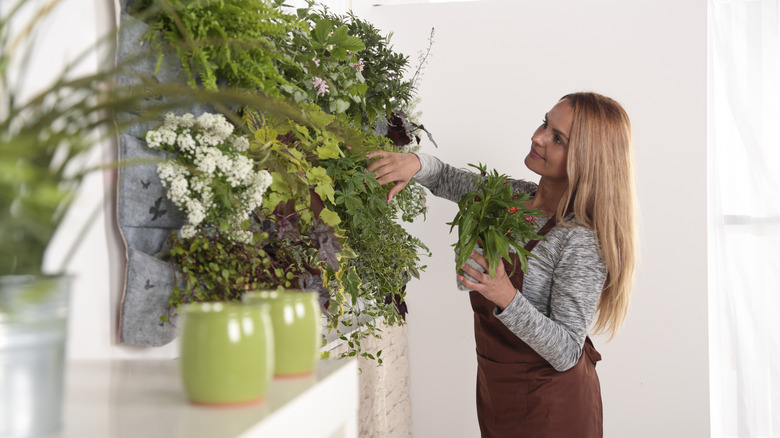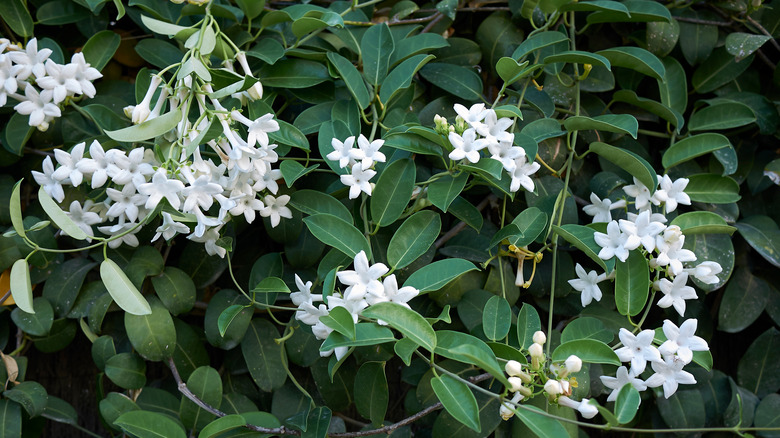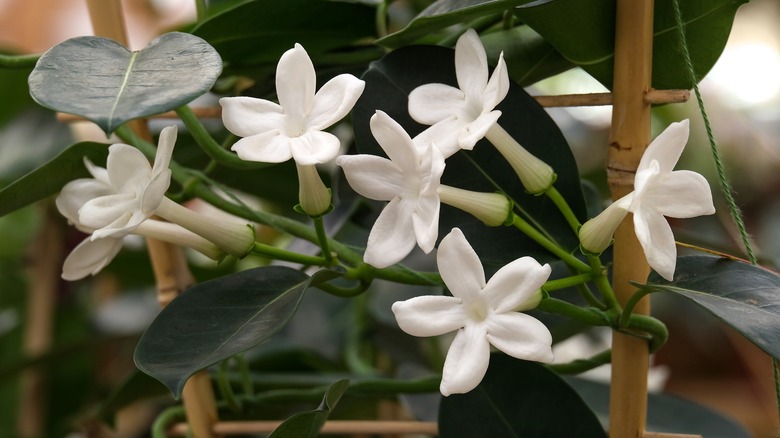Grow This Gorgeous White Flowering Vine Indoors For Season-Long Blooms
Keeping your home clean and tidy can help to reduce household odors, but many people turn to candles, plug-ins, and aerosol sprays to give their home an extra fresh edge. Unfortunately, many of these manufactured fragrances aren't great for our health. According to research conducted by the College of Applied Medical Sciences, the synthetic fragrances in many household products release phthalates into the air, which have been shown to exacerbate allergies, trigger asthma, and even alter hormones and cause cardiovascular issues. It's no secret that plant respiration and photosynthesis can improve the air quality in your home, but what if your houseplants could make the space smell delicious too? It turns out you actually grow beautiful, fragrant flowers indoors. When it comes to indoor flowering houseplants, few shine brighter (or smell lovelier) than Madagascar jasmine.
Madagascar jasmine might seem like a relatively uncommon houseplant, but it's a favorite among plant parents for a good reason. Here's why this delicate vine is so treasured, how it handles household conditions, and what you can do to ensure a Madagascar jasmine continues to thrive and bloom inside your home.
Madagascar jasmine offers enchanting flowers
Stephanotis floribunda, also known as Madagascar jasmine, bride's flower, Hawaiian wedding flower, or clustered wax flower, is a climbing evergreen vine that is native to the island of Madagascar, located near the southeastern coast of Africa. This woody vine eagerly climbs against trees, branches, shrubs, and rocks in nature, but is also surprisingly content to be grown as a houseplant, so long as it has climbing supports and access to plenty of sunlight. Peat-free and soil-rich compost is the ideal growing medium for these plants, which can tolerate repotting about every two years. Madagascar jasmine thrives at temperatures between 68 to 90 degrees Fahrenheit, so it's a good houseplant for folks who like to keep their home on the warm side.
Madagascar jasmine is one of the best vining plants to give your home a fresh look, with its thick, deep green leaves and waxy white blooms that emerge in nature from spring to autumn and last for up to a month. In the right conditions, you can even keep this plant blooming year-round! The flowers of Madagascar jasmine exude a sweet, uplifting scent that is very similar to tuberose and other types of jasmine. Its bright white blooms and intoxicating aroma make Madagascar jasmine a popular choice in wedding bouquets and bridal flower crowns — hence the nickname "bride's flower".
Encouraging your Madagascar jasmine to bloom
It can be difficult to coax Madagascar jasmine into re-blooming, especially indoors, but following proper care techniques should increase your chances of beautiful, sweet flowers returning year-round. Madagascar jasmine likes full sun, so keep it in a bright window with plenty of direct light. Adequate lighting is essential to get the plant to bloom. These tropical plants also appreciate humidity, so you can ditch the air freshener and use this plant for a sweet-smelling bathroom with a bright windowsill. Avoid overwatering, but quench your plant with tepid water every 1-2 weeks when the soil is dry, and mist every few days or keep it near a pebble tray full of water for humidity. Blooms may form on their own, but using a potassium-rich liquid fertilizer can help to give your plant an extra boost.
Once the flowers bloom, be cautious about moving your plant – the delicate flowers could be shaken from the vine. When the flowers are in full bloom, you can hand-pollinate them with a cotton swab or clean paintbrush, moving pollen from the male flower anthers to the female flower stigmas. With a little luck, the pollinated blooms may turn into small fruits! These fruits aren't poisonous, but they also aren't edible. They do, however, contain lots of tiny seeds that you can harvest to grow more Madagascar jasmine plants. Alternatively, the plant can be propagated from stem cuttings and transferred directly to compost.


